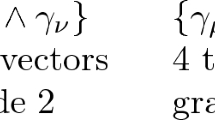Summary
In this paper Weyl’s gauge postulate is extended to include the mass term in a complex space. A generally covariant equation and an equivalence relation are then introduced that unify the matter, electromagnetic and gravitational fields in this space. These expressions lead directly to the Klein-Gordon equations as well as to more general wave equations including those for pseudoscalar fields. Consideration is then given to the noninvariant terms under the gauge postulate and it is shown that these terms represent measurable quantities in the laboratory space. Einstein’s free-space field equations are then developed within the context of this theory and the Yukawa problem is solved as an application of these equations. In addition to the Yukawa potential, two core potentials are obtained. Finally, Maxwell’s free-space field equations are developed and the central-charge problem is solved as an application of this theory.
Riassunto
In questo articolo si estende il postulato di gauge di Weyl per includere il termine di massa in uno spazio complesso. Si introducono successivamente una equazione generalmente covariante ed una relazione di equivalenza per unificare in questo spazio i campi gravitazionale, elettromagnetico e della materia. Queste espressioni conducono direttamente tanto alle equazioni di Klein-Gordon quanto ad equazioni d’onda più generali comprendenti quelle per campi pseudosoalari. Si considerano poi i termini non invarianti per il postulato di gauge e si dimostra che questi termini rappresentano quantità misurabili nello spazio del laboratorio. Si sviluppano poi le equazioni di campo dello spazio libero di Einstein secondo questa teoria e si risolve il problema di Yukawa come applicazione di queste equazioni. Si ottengono due potenziali di nocciolo oltre al Potenziale di Yukawa. Infine si sviluppano le equazioni di campo per lo spazio libero di Maxwell e si risolve, come applicazione di questa teoria, il problema della carica centrale.
Резюме
В этой статье обобщае тся калибровочный по стулат Вейля, чтобы включить массо вый член в комплексно е пространство. Затем вводятся ковариантное уравне ние и соотношение экв ивалентности, чтобы о бъединить вещество, электромагнитные и г равитационные поля в этом пространстве. Эт и выражения приводят непосредст венно к уравнениям Кл ейна-Гордона, а также к более общим волновым уравнениям, включая уравнения дл я псевдоскалярных по лей. Затем проводится рассмотр ение неинвариантных членов относительно калибровочного постулата и показыва ется, что эти члены пре дставляют измеримые величины в лабораторном простр анстве. В связи с этой т еорией затем развива ются уравнения поля для свободного п ространства Эйнштей на, и как применение эт их уравнений решается проблема Юк авы. Кроме потенциала Юкавы получаются пот енциалы двух центров. В заключение, развиваются уравнен ия для свободного про странства Максвелла и как прило жение этой теории реш ается проблема центр ального заряда.
Similar content being viewed by others
References
H. Weyl:Sitzungsber. Preuss. Akad. Wiss. (1918), p. 465.
P. G. Bergmann:Introduction to the Theory of Relativity (Englewood Cliffs, N.J., 1942).
T. Y. Thomas:Concepts from Tensor Analysis and Differential Geometry, 2nd Edition (New York and London, 1965)
I. S. Sokolnikoff:Tensor Analysis, 2nd Edition (New York, London, Sydney, 1964).
G. Møller:The Theory of Relativity (London, 1952).
H. Weyl:Space-Time-Matter (New York, 1952).
J. L. Synge andA. Schild:Tensor Calculus (Toronto, 1952).
E. M. Corson:Introduction to Tensors, Spinors and Relativistic Wave-Equations (London, 1953).
A. R. Forsyth:A Treatise on Differential Equations (London, 1956).
E. Schrödinger:Space-Time Structure (Cambridge, 1963).
E. Kretschmann:Ann. der Phys.,53, 575 (1917).
A. Einstein:Ann. der Phys.,55, 241 (1918).
H. S. Ruse:Proc. Roy. Soc. (Edinburgh),57, 97 (1937).
Author information
Authors and Affiliations
Rights and permissions
About this article
Cite this article
Cherry, N.H. A general-relativistic scalar field theory in the complex Weyl space. Nuov Cim B 4, 144–163 (1971). https://doi.org/10.1007/BF02737572
Received:
Published:
Issue Date:
DOI: https://doi.org/10.1007/BF02737572



